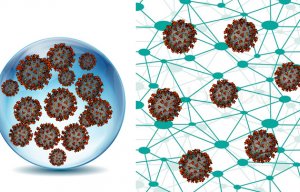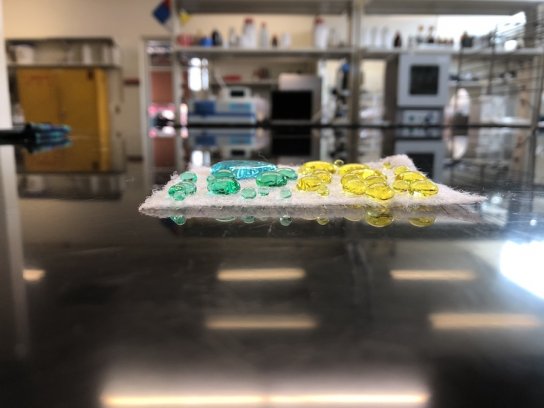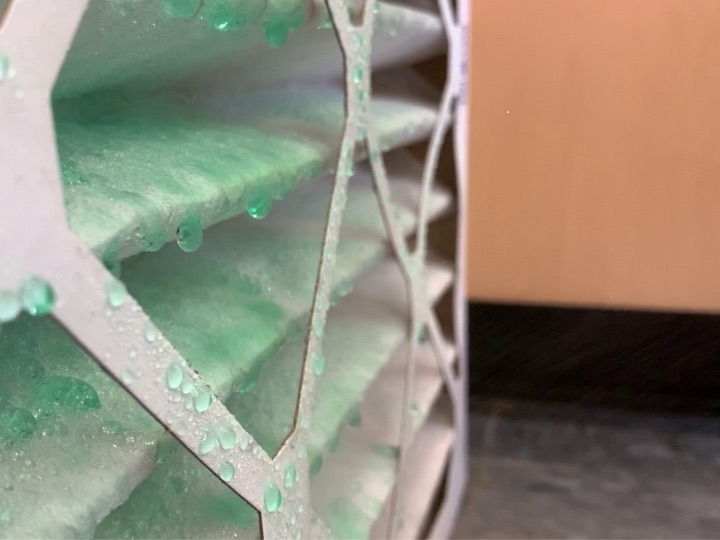
Capture Coating effectively kills Covid-19 indoors
A nanocoating for the filters used in heating, ventilation and air conditioning systems can capture and kill SARS-Cov-2 and could prove to be useful tool in the fight against the human coronavirus pandemic.

7th December 2020
Innovation in Textiles
|
Houston, Texas, USA
A nanocoating for the filters used in heating, ventilation and air conditioning systems can capture and kill SARS-Cov-2 and could prove to be useful tool in the fight against the human coronavirus pandemic. James Bakewell spoke to the inventor of the coating, Curran Biotech founder Seamus Curran, to find out more.
The human coronavirus (covid-19) pandemic has had a profound impact across the globe this year, but few places have been hit harder than New York City in the USA. According to the city's Department of Health and Mental Hygiene, nearly 18,000 people there died with covid-19 in March, April and May. In the summer, after a stringent lockdown, the city started to open-up again as some control was wrestled over the spread of the virus and precautions now familiar to many of us were adopted—the wearing of face coverings and the practice of social distancing, for instance. And in one of the courthouses in the city, these measures are being augmented with a small modification to the building’s heating, ventilation and air-conditioning (HVAC) system that enables it to strip the SARS-Cov-2 virus responsible for the pandemic from the air.
The air filters in the HVAC system have been treated with a hydrophobic, water-based nanocoating that enables them to capture airborne or aerosolised droplets of liquid containing SARS-Cov-2. According to its developer, Curran Biotech of Houston, Texas, USA, the coating is inexpensive, easy to apply and does not inhibit the flow of air through the filters.

Currently, there are three vehicles for the transmission of SARS-Cov-2 recognised by health authorities: small droplets of liquid generated by people as they speak or cough, which can end up in the eyes, mouth or nose of people standing nearby; contaminated surfaces; and the inhalation of aerosols exhaled by infected people. In enclosed spaces without ventilation, such aerosols remain suspended in the air and become increasingly concentrated as time passes—increasing the risk of infection. The Founder of Curran Biotech, Seamus Curran, says: “The spikes in cases of covid-19 seen in Europe in the Autumn were due in part to people mixing with each other in enclosed spaces. If you could clean the air in those rooms, infection rates would drop astronomically."
Diluting indoor air with fresh air from outside reduces the density of the infected aerosols. This can be achieved simply by opening windows, but this course of action can generate turbulent airflows that carry infected aerosols released by one person to other occupants in the room. Further, it can make spaces uncomfortable in places such as New York City, where winter temperatures often drop south of 0°C. Fresh air can also be introduced into a space through the HVAC system, but again, in cold climates, this air will need to be heated—an energy-intensive process.
Working through this problem, Curran – who is also a professor of physics at the University of Houston – wondered if there was a way that the air within a space could be cleaned and recirculated—eliminating any issues associated with the intake of cold air. To do so, he would need a filter that could remove the SARS-Cov-2 virus from the air.
The filters used in HVAC systems are characterised by their minimum efficiency reporting values (MERVs), which reflect their ability to capture particles, and many home HVAC systems in the USA have a MERV-8 filter installed by default. Curran says: “MERV 8 filters are also commonly used in large buildings, such as hospitals and in schools, but for them to clean the air by 95%, it needs to be filtered 45 times”. Filters with MERV-13 or higher ratings can trap smaller particles, including viruses, but they are approximately five times more expensive than their lower-rated counterparts. Perhaps more importantly, they are denser, more complex structures, and are therefore less permeable to air. This means that a HVAC system will have to work harder, and consume more energy, to pull air through them. Indeed, to run higher-MERV-rated filters, the system might have to be replaced altogether—a significant capital outlay. Further, even filters with high MERV ratings do not trap all viruses.

To solve this issue, Curran has drawn on his extensive experience of developing hydrophobic nanocoatings. He has built a successful company, Integricoate, which manufactures such coatings that prevent the build-up of mould and mildew on the surfaces of construction materials. Curran continues: “We started developing fabric coatings years ago as a fluorocarbon-free alternative to conventional waterproof coatings. These coatings could be antimicrobial and even antiviral, but at the time the US textiles industry was not interested. We therefore dropped textiles completely, and focused on construction materials.”
With the outbreak of the human coronavirus pandemic, however, Curran realised that the properties of his coatings could be useful in the fight against the virus. He says: “In March 2020, we developed hydrophobic coatings for face masks that would prevent any droplets of moisture from wicking through them, and have been producing masks with a big fabric company, which should be launched before then end of December 2020.”
Curran’s coating for filters operates on similar principles. Once applied, the non-toxic, hydrophobic, silicone-based material wraps itself around the fibres in a fabric filter. While it does not change the dimensions of the fibres – and thereby the air-permeability of the filter – the coating does prevent droplets of moisture from passing through them. The hydrophobicity of the coating then ensures that these droplets evaporate, causing the virions that they contain to desiccate within about half an hour of being captured. Curran says: “There's no active ingredient, like you would find in a detergent. All we are doing is removing the vehicle by which the virus is transported—the moisture”. In fact, Curran adds, pollen and other particles that are not encapsulated in fluids still pass through the filter.
The coating certainly appears to be effective. Curran says that testing at an independent laboratory, Water Lens of Houston, has confirmed that a filter treated with the coating captured airborne or aerosolised droplets of SARS-Cov-2 while, in comparison, it flowed through untreated filters of the same MERV rating. Additionally, the lab could not find even trace virus ribonucleic acid (RNA) on the surface of the treated filter a half-hour after exposure.
The coating is inexpensive and, in liquid from, can be applied easily to a filter using such as a hand-pump. Curran says: “Using our coating, we can create a MERV 6 or 8 filter that can block the virus better than a MERV 16 filter. Further, the filter requires no investment in capital equipment to use.”
The coating is being trialled in the HVAC system of the courthouse in New York City. Curran says that, having been hit so hard early on, city authorities there are very open to new solutions to the problems thrown up by the covid-19 pandemic. He continues: "They've been able to flush building interiors with outside air during the summer, but in the winter, the outside air is freezing cold and needs to be heated to 18–20°C, in large volumes, continuously. This requires a huge amount of energy, something the city is keen to avoid. So a system whereby the air from inside the building can be cleaned effectively is highly attractive.”
Curran Biotech is currently in the process of rolling the technology out across the rest of the USA and hopes to have established manufacturing operations in Europe by the end of 2020. Curran concludes: "The coating is one a number of solutions to the covid-19 pandemic, and an important one. Wear a mask, wash your hands, clean your surfaces and clean your air. If these precautions are taken, the risk of infection is minimal."

Business intelligence for the fibre, textiles and apparel industries: technologies, innovations, markets, investments, trade policy, sourcing, strategy...
Find out more